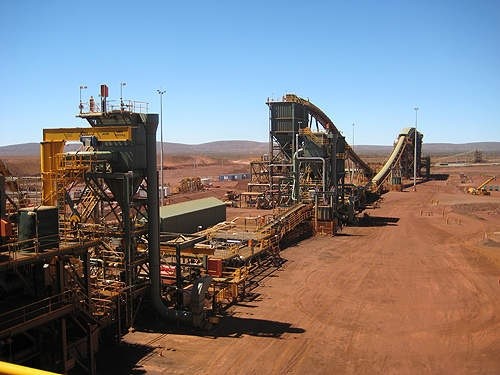Coal
Coal (from the Old English term col, which has meant "mineral of fossilized carbon" since the 13th century. is a combustible black or brownish-black sedimentary rock usually occurring in rock strata in layers or veins called coal beds or coal seams. The harder forms, such as anthracite coal, can be regarded as metamorphic rock because of later exposure to elevated temperature and pressure. Coal is composed primarily of carbon along with variable quantities of other elements, chiefly hydrogen, sulfur, oxygen, and nitrogen.
Throughout history, coal has been used as an energy resource, primarily burned for the production of electricity and/or heat, and is also used for industrial purposes, such as refining metals. A fossil fuel, coal forms when dead plant matter is converted into peat, which in turn is converted into lignite, then sub-bituminous coal, after that bituminous coal, and lastly anthracite. This involves biological and geological processes that take place over a long period. The United States Energy Information Administration estimates coal reserves at 7011948000000000000♠948×109 short tons (860 Gt). One estimate for resources is 18 000 Gt. Coal is extracted from the ground by coal mining, either underground by shaft mining, or at ground level by open pit mining extraction. Since 1983 the world top coal producer has been China.
Coal is the largest source of energy for the generation of electricity worldwide, as well as one of the largest worldwide anthropogenic sources of carbon dioxide releases. In 1999, world gross carbon dioxide emissions from coal usage were 8,666 million tonnes of carbon dioxide. In 2011, world gross emissions from coal usage were 14,416 million tonnes.
Supply/Demand
After reaching an all-time high this year, global coal demand is expected to decline to 2026, according to the latest edition of the International Energy Agency’s (IEA) annual coal market report – the first time that the report has predicted a drop in global coal consumption over its forecast period.
Coal 2023 sees global demand for coal rising by 1.4% in 2023, surpassing 8.5 billion tonnes for the first time. The global increase masks stark differences among regions. Consumption is on course to decline sharply in most advanced economies in 2023, including record drops in the European Union and United States of around 20% each. Demand in emerging and developing economies, meanwhile, remains very strong, increasing by 8% in India and by 5% in China in 2023 due to rising demand for electricity and weak hydropower output.
However, the report expects global coal demand to fall by 2.3% by 2026 compared with 2023 levels, even in the absence of governments announcing and implementing stronger clean energy and climate policies. This decline is set to be driven by the major expansion of renewable energy capacity coming online in the three years to 2026.
More than half of this global renewable capacity expansion is set to occur in China, which currently accounts for over half of the world’s demand for coal. As a result, Chinese coal demand is expected to fall in 2024 and plateau through 2026. That said, the outlook for coal in China will be significantly affected in the coming years by the pace of clean energy deployment, weather conditions, and structural shifts in the Chinese economy.
The projected decline in global demand for coal – which is currently the largest energy source for electricity generation, steelmaking and cement production, but also the largest source of carbon dioxide (CO2) emissions from human activity – could mark a historic turning point. However, global consumption is forecast to remain well over 8 billion tonnes through 2026, according to the market report. To drive down emissions at a rate consistent with the goals of the Paris Agreement, the use of unabated coal would need to fall significantly faster.
‘’We have seen declines in global coal demand a few times, but they were brief and caused by extraordinary events such as the collapse of the Soviet Union or the Covid-19 crisis. This time appears different, as the decline is more structural, driven by the formidable and sustained expansion of clean energy technologies,” said Keisuke Sadamori, IEA Director of Energy Markets and Security. “A turning point for coal is clearly on the horizon – though the pace at which renewables expand in key Asian economies will dictate what happens next, and much greater efforts are needed to meet international climate targets.”
The report finds that the shift in coal demand and production to Asia is accelerating. This year, China, India and Southeast Asia are set to account for three-quarters of global consumption, up from only about one-quarter in 1990. Consumption in Southeast Asia is expected to exceed for the first time that of the United States and that of the European Union in 2023. Through 2026, India and Southeast Asia are the only regions where coal consumption is poised to grow significantly. In advanced economies, the expansion of renewables amid weak electricity demand growth is set to continue driving the structural decline of coal consumption.
Meanwhile, China, India and Indonesia – the three largest coal producers globally – are expected to break output records in 2023, pushing global production to a new high in 2023. These three countries now account for more than 70% of the world’s coal production.
Global coal trade is expected to contract as demand declines in the years ahead. However, trade will reach a new high in 2023, driven by strong growth in Asia. Chinese imports are on track to reach 450 million tonnes, which is more than 100 million tonnes above the previous global record set by the country in 2013, while Indonesia’s exports in 2023 will be close to 500 million tonnes – also a global record.








